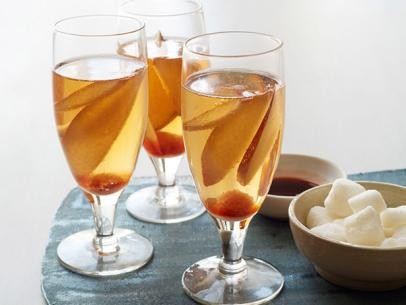Clear fruit brandies make a comeback
April 19, 2015 by Darcie
Have you ever seen a bottle of pear brandy where an entire pear rests serenely at the bottom, and wondered how the heck they get the pear in there? Wonder no more, as NPR’s The Salt explains the process of making fruit eaux-de-vie, and how the liqueur is experiencing a renaissance.
Perhaps you already figured out that the pear grows inside the bottle. Each spring in Alsace, workers tie bottles onto pear blossoms. Once the fruit is ripe, “they remove the bottles and pluck off leaves, clean the pear and glass, and finally, pour in colorless pear brandy – distilled from last year’s harvest. Once they seal it up, voila, they’ve made a beautiful bottle of brandy with a whole pear inside. This is the astonishing, age-old tradition first invented in Alsace in the 1700s and known as eau de vie de poire, or pear water of life.”
Lately, this type of clear fruit brandy has made a comeback, especially in America, as part of the locavore and craft distllery movements. Dozens of U.S. distilleries have begun crafting dry, fragrant liqueurs from mashed and fermented fruits including cherries, pears, plums, raspberries, apples and peaches. (Unlike the pear brandy, these usually don’t have whole fruit inside the bottle. More’s the pity.)
The eau-de-vie making process is fairly straightfoward, as mashed fruit pulp is fermented and distilled. It takes about two weeks to ferment the mash with yeast and form alcohol from the fruit sugars. The mash is then loaded into a still and clear brandy with essence of ripe fruit emerges. The distilled liqueur is aged for about a year before being bottled and sold.
So what happens to the pear inside the bottle of pear eau-de-vie? First, “the pear releases sugars into the brandy, giving it a sherried quality, while the fruit absorbs the alcohol.” Aficionados eat the brandy-soaked pear by carefully breaking the bottle and washing the pear thoroughly to remove any glass fragments.
Higher proof brandies are often served as an after dinner digestif or used in cooking to add fruity aromas to sauces. They’re also perfect for making cocktails like the Pear-brandy cocktails from Food Network Magazine pictured above.
Categories
- All Posts (6940)
- Antipasto (2135)
- Author Articles (247)
- Book News (935)
- Cookbook Giveaways (983)
- Cookbook Lovers (257)
- Cooking Tips (109)
- Culinary News (299)
- Food Biz People (552)
- Food Online (791)
- Holidays & Celebrations (272)
- New Cookbooks (149)
- Recipes (1500)
- Shelf Life With Susie (231)
- What's New on EYB (133)
Archives
Latest Comments
- Atroyer7 on Danube Cookbook Review and Giveaway
- demomcook on What foods do you look forward to the most for each season?
- demomcook on Danube Cookbook Review and Giveaway
- Darcie on How cookbooks can help build resilience
- mholson3 on Danube Cookbook Review and Giveaway
- Rinshin on How cookbooks can help build resilience
- sarahawker on Danube Cookbook Review and Giveaway
- Sand9 on Danube Cookbook Review and Giveaway
- hankintoby29 on Heritage Cookies of the Mediterranean World – Cookbook Giveaway
- WBB613 on Feasts of Good Fortune Cookbook Giveaway